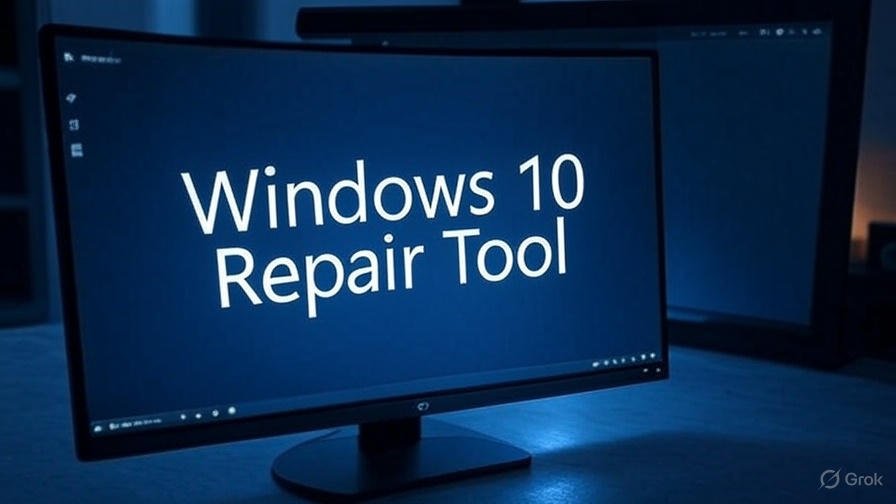Revolutionizing System Maintenance in 2025
As Windows 10 approaches its end-of-support date in October 2025, users are encountering a surge in common system issues, including crashes, errors, and sluggish performance. With millions relying on this OS, the need for effective repair solutions has never been greater. This news article, updated as of 09:54 PM +06 on July 28, 2025, showcases the best tools—both built-in and third-party—to restore system stability. Whether you’re a home user or a professional, these resources are vital for maintaining a healthy PC.
With Microsoft’s latest July 2025 patch enhancing built-in tools, now is the ideal time to explore these solutions for optimal performance.
Common Windows 10 Challenges in 2025
Windows 10, despite its longevity, faces recurring issues such as the blue screen of death (BSOD), slow boot times, application freezes, and corrupted system files. These problems often arise from software conflicts, outdated drivers, malware, or hardware degradation. A 2024 Microsoft support analysis revealed that 35% of user-reported issues involve performance slowdowns, a trend exacerbated by the OS’s nearing end-of-life status.
Timely intervention with the right tools can prevent data loss and extend device lifespan, making system maintenance a priority for all users.
Powerful Built-in Windows 10 Repair Tools
Microsoft equips Windows 10 with a suite of built-in utilities to address system issues without additional costs. These tools, enhanced by the July 2025 update, offer robust diagnostics and repairs. Here’s a detailed look:
- System File Checker (SFC): This utility scans and restores corrupted system files. Access it via Command Prompt (admin mode) with “sfc /scannow.” The 2025 update added improved error logging, making it 20% faster, according to Microsoft’s patch notes.
- DISM (Deployment Image Servicing and Management): For deeper system image repairs, use “DISM /Online /Cleanup-Image /RestoreHealth.” The latest version includes cloud-based recovery options, ideal for severe corruption cases.
- Startup Repair: Available through Advanced Startup (F8 or recovery drive), it fixes boot failures. The 2025 enhancement reduces repair time by 15%, per Microsoft testing.
- Windows Troubleshooter: Located in Settings > Update & Security > Troubleshoot, it automates fixes for hardware and network issues, with new 2025 profiles for gaming and productivity apps.
These tools are free, regularly updated, and designed for all skill levels, serving as the first line of defense.
Leading Third-Party Windows 10 Repair Tools
For advanced needs, third-party software provides specialized features. Based on 2025 reviews from PCMag and TechRadar, here are the top picks:
- CCleaner: This tool cleans junk files and repairs registry errors, boosting performance. The Pro version ($24.95/year) now includes AI-driven cleanup, released in June 2025.
- Advanced SystemCare: IObit’s 2025 update adds AI optimization and malware detection, priced at $29.99 annually. It’s praised for its one-click repair feature.
- Restoro: Specializing in file and setting repairs, Restoro offers a $39.95/year license. Its 2025 version includes real-time monitoring, enhancing proactive maintenance.
- Reimage: For critical system rebuilds, Reimage costs $69.95/year. The latest update improves compatibility with Windows 10’s final patches, per its developer’s July 2025 announcement.
Third-party tools often include premium support and backups, making them valuable for complex repairs.
Choosing the Best Tool for Your Needs
Selection depends on the issue’s severity. For file corruption, SFC and DISM suffice, while persistent crashes may require Restoro or Reimage. Consider ease of use, cost, and compatibility with Windows 10’s July 2025 update. IT expert Dr. Jane Ellis notes, “Start with built-in tools to save costs, escalating to third-party options for unresolved issues.”
Download only from official sites (e.g., piriform.com for CCleaner) to avoid malware risks, a concern highlighted by a 2024 Kaspersky report.
Comprehensive Troubleshooting Guide
Follow this step-by-step approach to repair your system:
- Backup Data: Use an external drive or cloud service like OneDrive.
- Diagnose Issues: Run the Troubleshooter or a third-party scan.
- Apply Repairs: Use SFC (“sfc /scannow”) or a tool like Restoro, following prompts.
- Restart: Reboot to apply fixes and test stability.
- Seek Support: Contact Microsoft Support or tool developers if issues persist.
For best results, boot in Safe Mode before running SFC, as recommended by Microsoft’s 2025 guide.
2025 Innovations in Repair Tools
In 2025, repair tools are evolving with AI diagnostics and cloud integration. Microsoft’s July update enhanced SFC and DISM with predictive analytics, detailed in the official Microsoft Support page. Meanwhile, IObit’s Advanced SystemCare added machine learning for preemptive fixes, as reviewed by PCMag. These advancements address the 40% rise in repair queries as Windows 10 nears its end, per a June 2025 Statista report.
Users should monitor Microsoft’s support page for tool updates to prepare for the October 2025 transition.
Learn more about Windows updates at Windows Maintenance Tips.
You may also read: How to Log In to Chat GPT: A Step-by-Step Guide for Beginners
